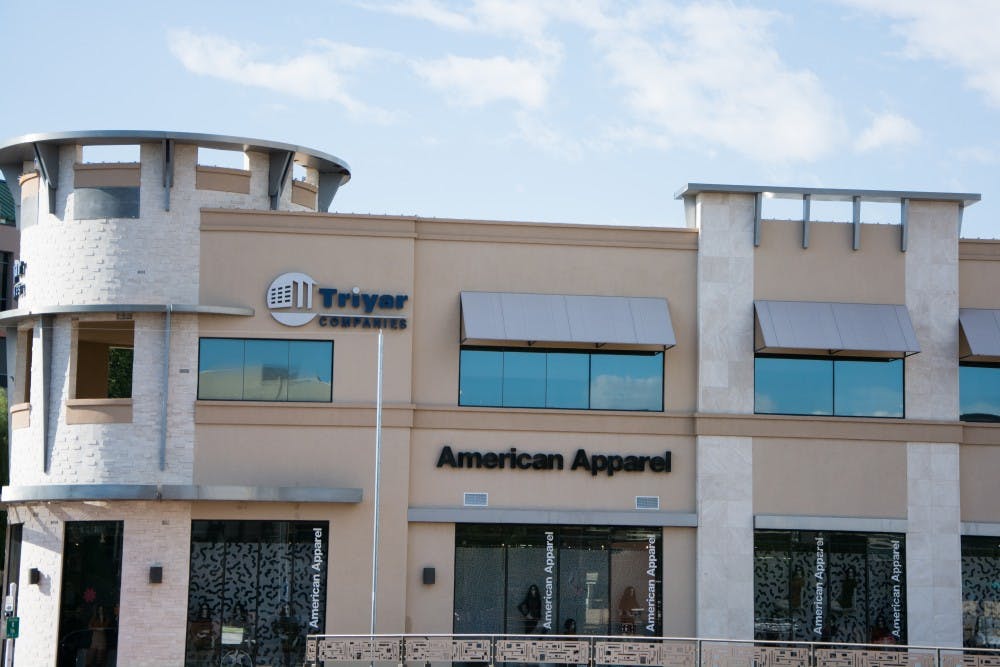Billboards sporting half-naked teenagers in American Apparel thigh-highs filled the world for too long. We're tired of buying overpriced scrunchies modeled by a nearly topless 18-year-old.
With a millennial generation demanding a more inclusive and socially aware future, American Apparel's exploitation will not linger for much longer. American Apparel filed for bankruptcy on Monday morning — and society may soon bid adieu to the company's raunchy, exploitive ads.
Read More: American Apparel finds itself in hairy situation over new mannequins
American Apparel always rode a thin line between revolutionary and objectifying, playing with the ideas of generational fads and objectifying young female models. I am a firm believer in being comfortable with human anatomy and accepting it for its beauty, intricacy and design. However, there is a difference between art and sexualization.
The Lolita fantasy, defined by the sexualization of young, usually thin girls is obnoxious in American Apparel’s advertisements. Many of the models are amateurs, giving off a girl-next-door vibe and alluding to the company’s iconic look. Although the company has experimented with models of various ethnicities, sexes and ages, the company's overall aesthetic remains unblemished — when you think of American Apparel, you think of school-girl scrubbed faces and counting the ribs under an exposed breast.
Comedian Amy Schumer half-joked, “I love American Apparel. I really do. I like the models and the marketing. I like that every shot of them, it looks like a shot of the last time they were ever seen. ‘Help.’ It looks like they are waiting for Liam Neeson in the bottom of a closet. It’s like hostage lighting.”
This marketing is the quintessential example of how U.S. society demonstrates a strict standard of beauty and instills it in everyone — the young girls who want to look like that, the men who lust after them and the women who wish they still looked that way. Several American Apparel ads have been banned, either because they were deemed too inappropriate or because they demeaned and exploited women.
Seeing as the company has been aggressively treading to keep its pouty-lipped, doe-eyed head above water for some time now, I am not surprised by its current state. It is finally slipping under.
Regarding our financial restructuring—this is a positive development. We remain committed to bringing you the US-made clothes you love.
— American Apparel (@americanapparel) October 5, 2015
The edgy, cool brand went through a bit of an identity crisis when it lost its founder and CEO, Dov Charney, following an onslaught of sexual misconduct charges in late 2014. Regardless of the underlying creepiness of a male in his mid-40s who was essentially selling the “naughty schoolgirl” aesthetic, Charney had a mountain of alleged rumors circulating about him.
Conducting business wearing one sock in such a way that the inventor of socks did not intend, masturbating in front of reporters and using slurs and sharing misogynistic comments with employees were just a few.
The business then changed leadership and took out a restraining order on Charney. Even with Paula Schneider as the new CEO, plastering Tumblr with freshly-legal models hasn’t gone away. To her credit, Schneider did push for a more diverse marketing campaign when she first took leadership with a “Pro-Women” ad campaign that starred the company’s very own employees. She offered a promise to “de-sleaze” the brands image. Obviously, with Chapter 11 bankruptcy now in the mix, her plan didn’t work.
American Apparel’s exploitive advertising and perpetration of women, especially young women, as sex objects is hopefully a thing of the past. If the company wants to survive, they are going to need to adapt. Clinging to the spread-legged teens in the company's catalogs or by embracing a more millennial-driven angle, they need to think fast. A debt of $300 million is something that no amount of wide-eyed, bare-legged girls can make up for.
Related Links:
Both women and men stereotyped by revealing clothing
In a world full of objectification, the Body Project aims to promote body acceptance
Reach the columnist at smmaki@asu.edu or follow @symmaki on Twitter.
Like The State Press on Facebook and follow @statepress on Twitter.
Editor’s note: The opinions presented in this column are the author’s and do not imply any endorsement from The State Press or its editors.
Want to join the conversation? Send an email to opiniondesk.statepress@gmail.com. Keep letters under 300 words and be sure to include your university affiliation. Anonymity will not be granted.




